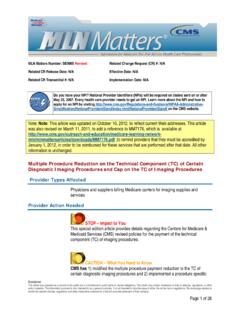Transcription of National Imaging Associates, Inc. LOWER EXTREMITY CT …
1 National Imaging Associates, Inc. Clinical guidelines LOWER EXTREMITY CT (Foot, Ankle, Knee, Leg or Hip CT) Original Date: September 1997 Page 1 of 5 CPT Codes: 73700, 73701, 73702 Last Review Date: August 2015 Guideline Number: NIA_CG_057-2 Last Revised Date: August 2015 Responsible Department: Clinical Operations Implementation Date: January 2016 1 LOWER EXTREMITY CT - 2016 Proprietary INTRODUCTION: Plain radiographs are typically used as the first-line modality for assessment of LOWER EXTREMITY conditions. Computed tomography (CT) is used for evaluation of tumors, metastatic lesions, infection, fractures and other problems. Magnetic resonance Imaging (MRI) is the first-line choice for Imaging of many conditions, but CT may be used in these cases if MRI is contraindicated or unable to be performed. INDICATIONS FOR LOWER EXTREMITY CT (FOOT, ANKLE, KNEE, LEG or HIP): Evaluation of suspicious mass/tumor (unconfirmed cancer diagnosis): Initial evaluation of suspicious mass/tumor found on an Imaging study and needing clarification or found by physical exam and remains non-diagnostic after x-ray or ultrasound is completed.
2 Suspected tumor size increase or recurrence based on a sign, symptom, Imaging study or abnormal lab value. Surveillance: One follow-up exam if initial evaluation is indeterminant and lesion remains suspicious for cancer. No further surveillance unless tumor is specified as highly suspicious, or change was found on last Imaging . Evaluation of known cancer: Initial staging of known cancer in the LOWER EXTREMITY . Follow-up of known cancer of patient undergoing active treatment within the past year. Known cancer with suspected LOWER EXTREMITY metastasis based on a sign, symptom, Imaging study or abnormal lab value. Prior cancer surveillance: Once per year (last test must be over 10 months ago before new approval) for surveillance of known cancer. For evaluation of known or suspected infection or inflammatory disease ( osteomyelitis) and MRI is contraindicated or cannot be performed: Further evaluation of an abnormality or non-diagnostic findings on prior Imaging .
3 With abnormal physical, laboratory, and/or Imaging findings. Known or suspected (based upon initial workup including Imaging ) septic arthritis or osteomyelitis. For evaluation of suspected (AVN) avascular necrosis ( , aseptic necrosis, Legg-Calve-Perthes disease in children) and MRI is contraindicated or cannot be performed: Further evaluation of an abnormality or non-diagnostic findings on prior Imaging . 2 LOWER EXTREMITY CT - 2016 Proprietary For evaluation of suspected or known Auto Immune Disease, ( Rheumatoid arthritis) and MRI is contraindicated or cannot be performed: Known or suspected auto immune disease and non-diagnostic findings on prior Imaging . For evaluation of known or suspected fracture and/or injury: Further evaluation of an abnormality or non-diagnostic findings on prior Imaging . Suspected fracture when Imaging is negative or equivocal. Determine position of known fracture fragments/dislocation. For evaluation of persistent pain, initial Imaging ( x-ray) has been performed and MRI is contraindicated or cannot be performed: Chronic (lasting 3 months or greater) pain and/or persistent tendonitis unresponsive to conservative treatment*, which include - medical therapy (may include physical therapy or chiropractic treatments) and/or - physician supervised home exercise** of at least four (4) weeks OR with progression or worsening of symptoms during the course of conservative treatment.
4 Pre-operative evaluation. Post-operative/procedural evaluation: When Imaging , physical, or laboratory findings indicate joint infection, delayed or non-healing, or other surgical/procedural complications. A follow-up study may be needed to help evaluate a patient s progress after treatment, procedure, intervention, or surgery. Documentation requires a medical reason that clearly indicates why additional Imaging is needed for the type and area(s) requested. Other indications for LOWER EXTREMITY (Foot, Ankle, Knee, Leg, or Hip) CT: Abnormal bone scan and x-ray is non-diagnostic or requires further evaluation. For evaluation of leg length discrepancy when physical deformities of the LOWER extremities would prevent standard modalities such as x-rays or a Scanogram from being performed. (Scanogram (CPT code 77073); bone length study is available as an alternative to LOWER EXTREMITY CT evaluation for leg length discrepancy). CT arthrogram and MRI is contraindicated or cannot be performed.
5 To assess status of osteochondral abnormalities including osteochondral fractures, osteochondritis dissecans, treated osteochondral defects where physical or Imaging findings suggest its presence and MRI is contraindicated or cannot be performed. Additional indication specific for FOOT or ANKLE CT: Chronic (lasting 3 months or greater) pain in a child or an adolescent with painful rigid flat foot where Imaging is unremarkable or equivocal or on clinician s decision to evaluate for known or suspected tarsal coalition. Accompanied by physical findings of ligament damage such as an abnormal drawer test of the ankle or significant laxity on valgus or varus stress testing and/or joint space widening on x-ray, and MRI is contraindicated or cannot be performed. Additional indications specific for KNEE CT and MRI is contraindicated or cannot be performed: Accompanied by blood in the joint (hemarthrosis) demonstrated by aspiration. 3 LOWER EXTREMITY CT - 2016 Proprietary Presence of a joint effusion.
6 Accompanied by physical findings of a meniscal injury determined by physical examination tests (McMurray s, Apley s) or significant laxity on varus or valgus stress tests. Accompanied by physical findings of anterior cruciate ligament (ACL) or posterior cruciate ligament (PCL) ligamental injury determined by the drawer test or the Lachman test. Additional indications specific for HIP CT: For any evaluation of patient with hip prosthesis or other implanted metallic hardware where prosthetic loosening or dysfunction is suspected on physical examination or Imaging . For evaluation of total hip arthroplasty patients with suspected loosening and/or wear or osteolysis or assessment of bone stock is needed. For evaluation of suspected slipped capital femoral epiphysis with non-diagnostic or equivocal Imaging and MRI is contraindicated or cannot be performed. Suspected labral tear of the hip with signs of clicking and pain with hip motion especially with hip flexion, internal rotation and adduction which can also be associated with locking and giving way sensations of the hip on ambulation and MRI is contraindicated or cannot be performed.
7 ADDITIONAL INFORMATION RELATED TO LOWER EXTREMITY CT: *Conservative Therapy: (musculoskeletal) should include a multimodality approach consisting of a combination of active and inactive components. Inactive components such as rest, ice, heat, modified activities, medical devices, (such as crutches, immobilizer, metal braces, orthotics, rigid stabilizer or splints, etc and not to include neoprene sleeves), medications, injections (bursal, and/or joint, not including trigger point), and diathermy, can be utilized. Active modalities may consist of physical therapy, a physician supervised home exercise program**, and/or chiropractic care. NOTE: for joint and EXTREMITY injuries, part of this combination may include the physician instructing patient to rest the area or stay off the injured part. **Home Exercise Program - (HEP) the following two elements are required to meet guidelines for completion of conservative therapy: Information provided on exercise prescription/plan AND Follow up with member with information provided regarding completion of HEP (after suitable 4 week period), or inability to complete HEP due to physical reason- increased pain, inability to physically perform exercises.
8 (Patient inconvenience or noncompliance without explanation does not constitute inability to complete HEP). CT and Ankle Fractures One of the most frequently injured areas of the skeleton is the ankle. These injuries may include ligament sprains as well as fractures. A suspected fracture is first imaged with conventional radiographs in anteroposterior, internal oblique and lateral projections. CT is used in patients with complex ankle and foot fractures after radiography. 4 LOWER EXTREMITY CT - 2016 Proprietary CT and Hip Trauma Computed tomography is primarily used to evaluate acute trauma, , acetabular fracture or hip dislocation. It can detect intraarticular fragments and associated articular surface fractures and it is useful in surgical planning. CT and Knee Fractures CT is used after plain films to evaluate fractures to the tibial plateau. These fractures occur just below the knee joint, involving the cartilage surface of the knee. Soft tissue injuries are usually associated with the fractures.
9 The meniscus is a stabilizer of the knee and it is very important to detect meniscal injury in patients with tibial plateau fractures. CT of the knee with two-dimensional reconstruction in the sagittal and coronal planes may be performed for evaluation of injuries with multiple fragments and comminuted fractures. Spiral CT has an advantage of rapid acquisition and reconstruction times and may improve the quality of images of bone. Soft tissue injuries are better demonstrated with MRI. CT and Knee Infections CT is used to depict early infection which may be evidenced by increased intraosseous density or the appearance of fragments of necrotic bone separated from living bone by soft tissue or fluid density. Contrast-enhanced CT may help in the visualization of abscesses and necrotic tissue. CT and Knee Tumors CT complements arthrography in diagnosing necrotic malignant soft-tissue tumors and other cysts and masses in the knee. Meniscal and ganglion cysts are palpable masses around the knee.
10 CT is useful in evaluations of the vascular nature of lesions. CT and Legg-Calve-Perthes Disease (LPD) This childhood condition is associated with an insufficient blood supply to the femoral head which is then at risk for osteonecrosis. Clinical signs of LPD include a limp with groin, thigh or knee pain. Flexion and adduction contractures may develop as the disease progresses and eventually movement may only occur in the flexion-extension plane. This condition is staged based on plain radiographic findings. CT scans are used in the evaluation of LPD and can demonstrate changes in the bone trabecular pattern. They also allow early diagnosis of bone collapse and sclerosis early in the disease where plain radiography is not as sensitive. CT and Osteolysis Since computed tomography scans show both the extent and the location of lytic lesions, they are useful to guide treatment decisions as well as to assist in planning for surgical intervention, when needed, in patients with suspected osteolysis after Total Hip Arthroplasty (THA).








